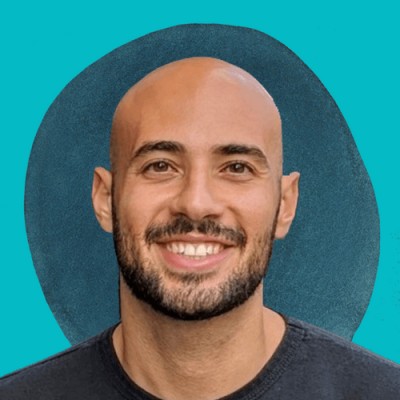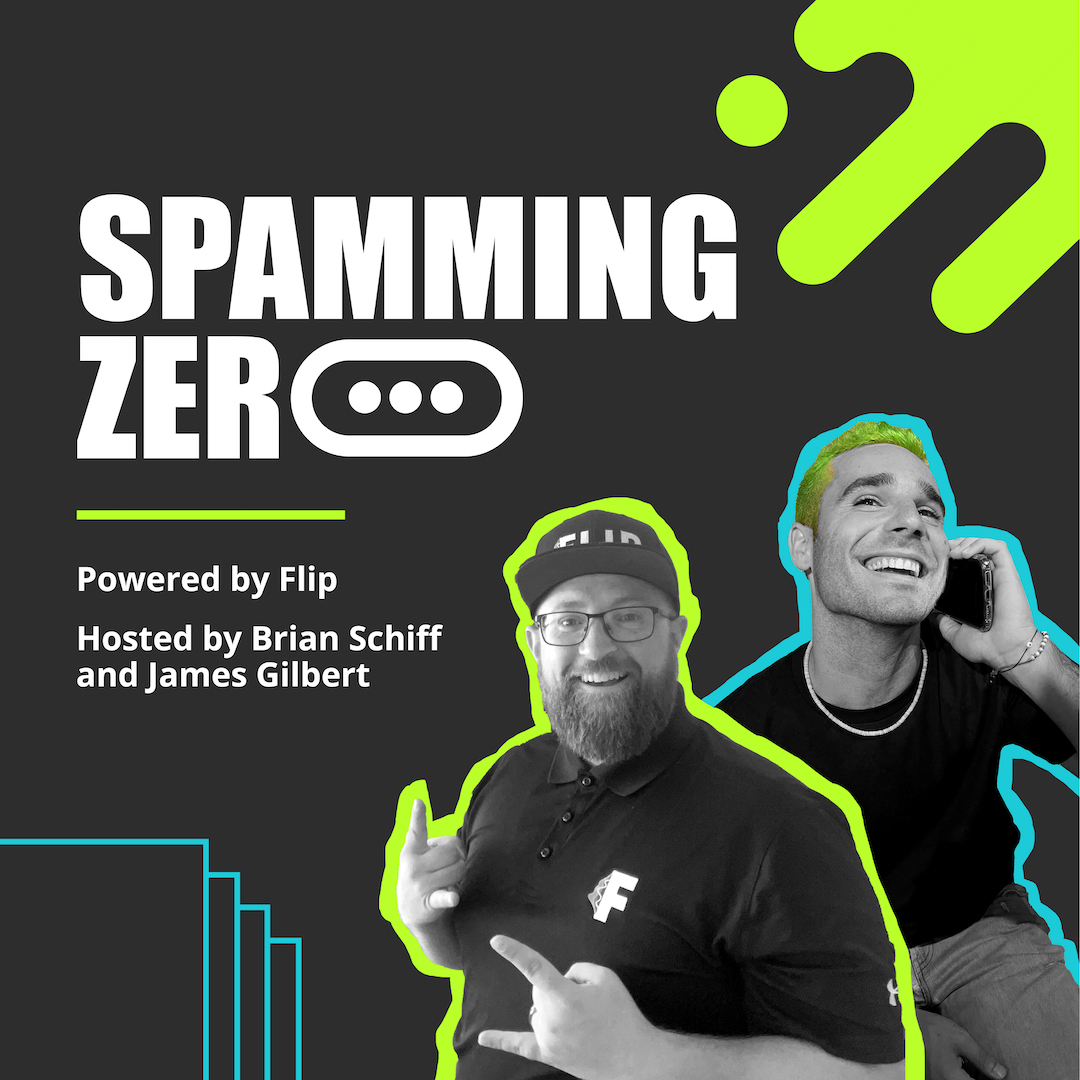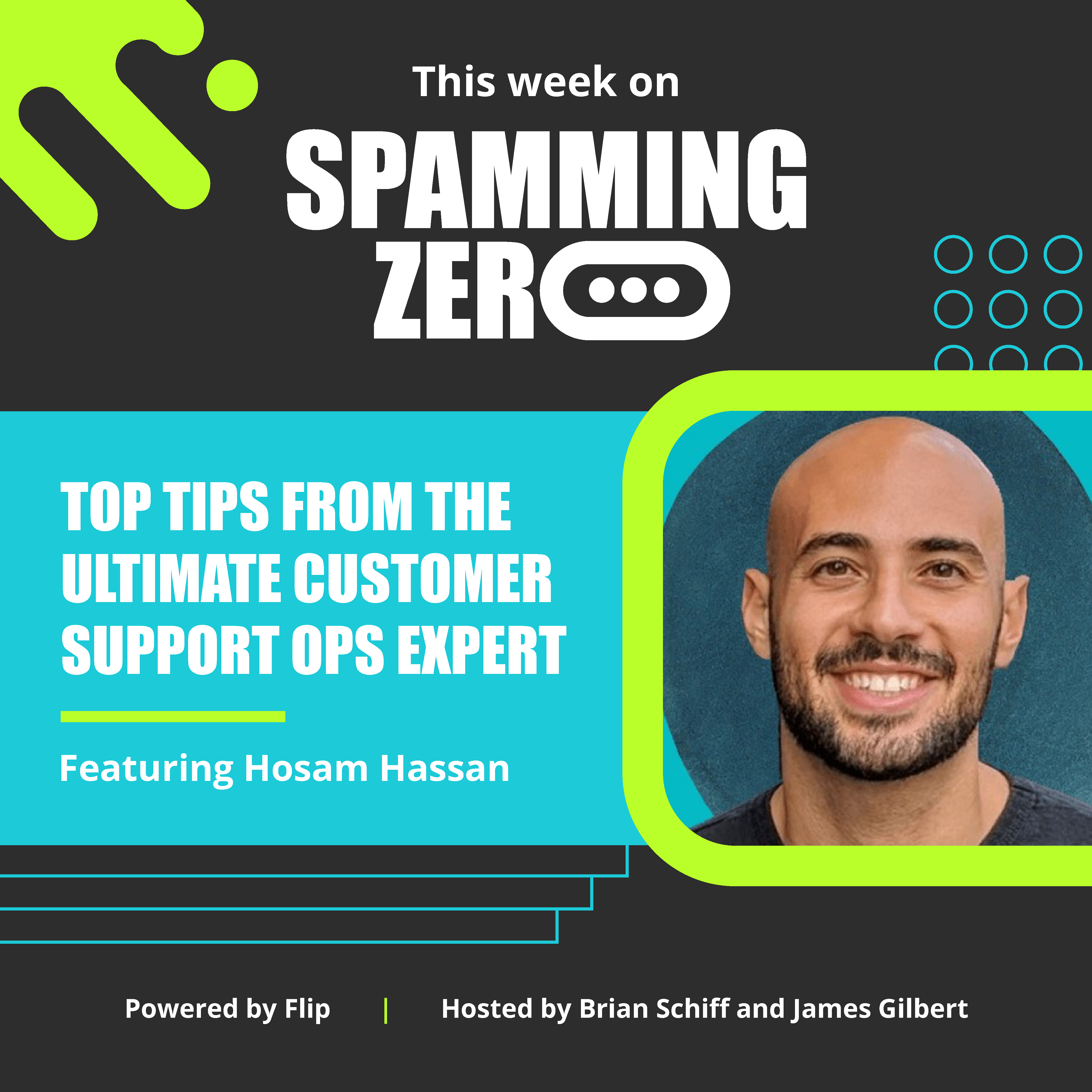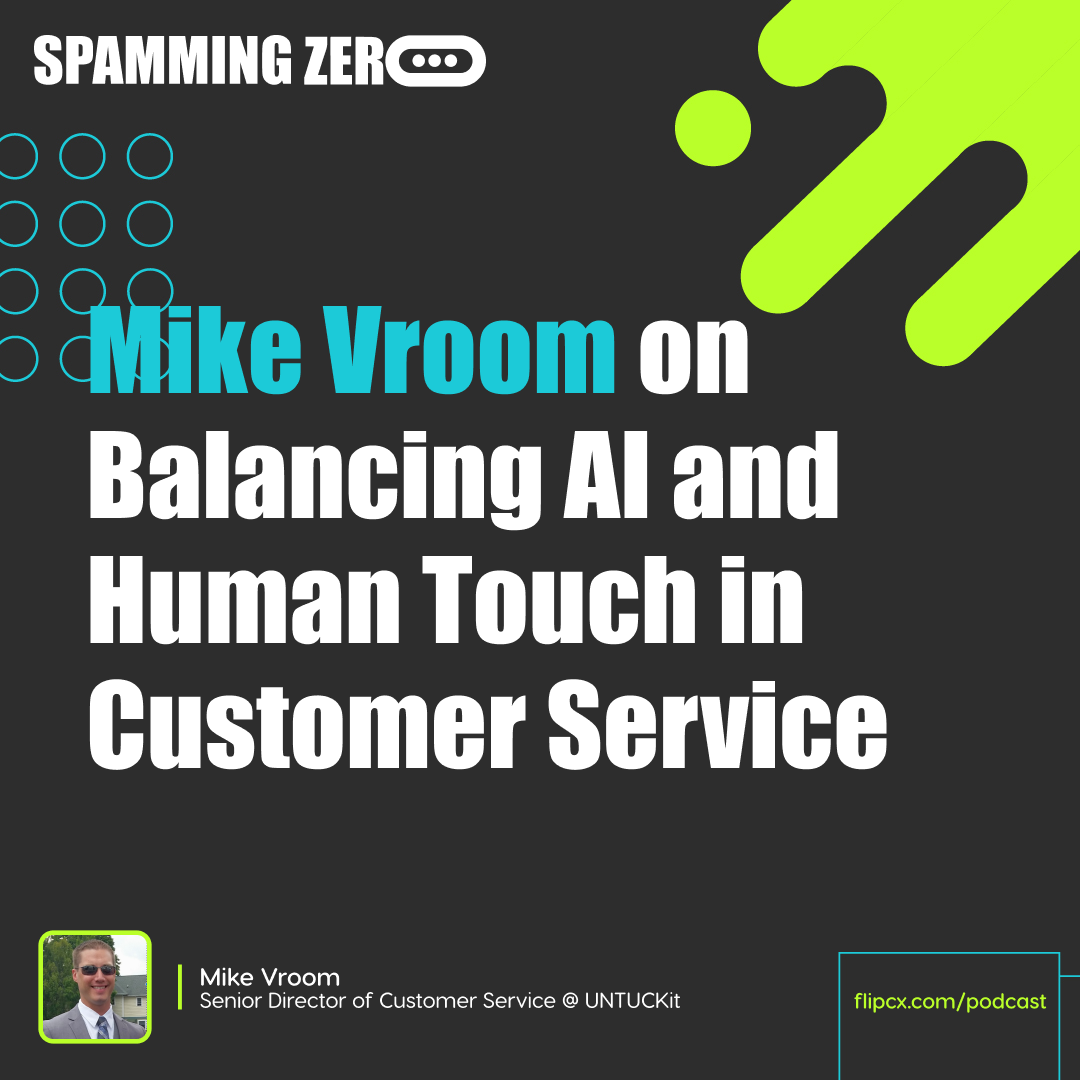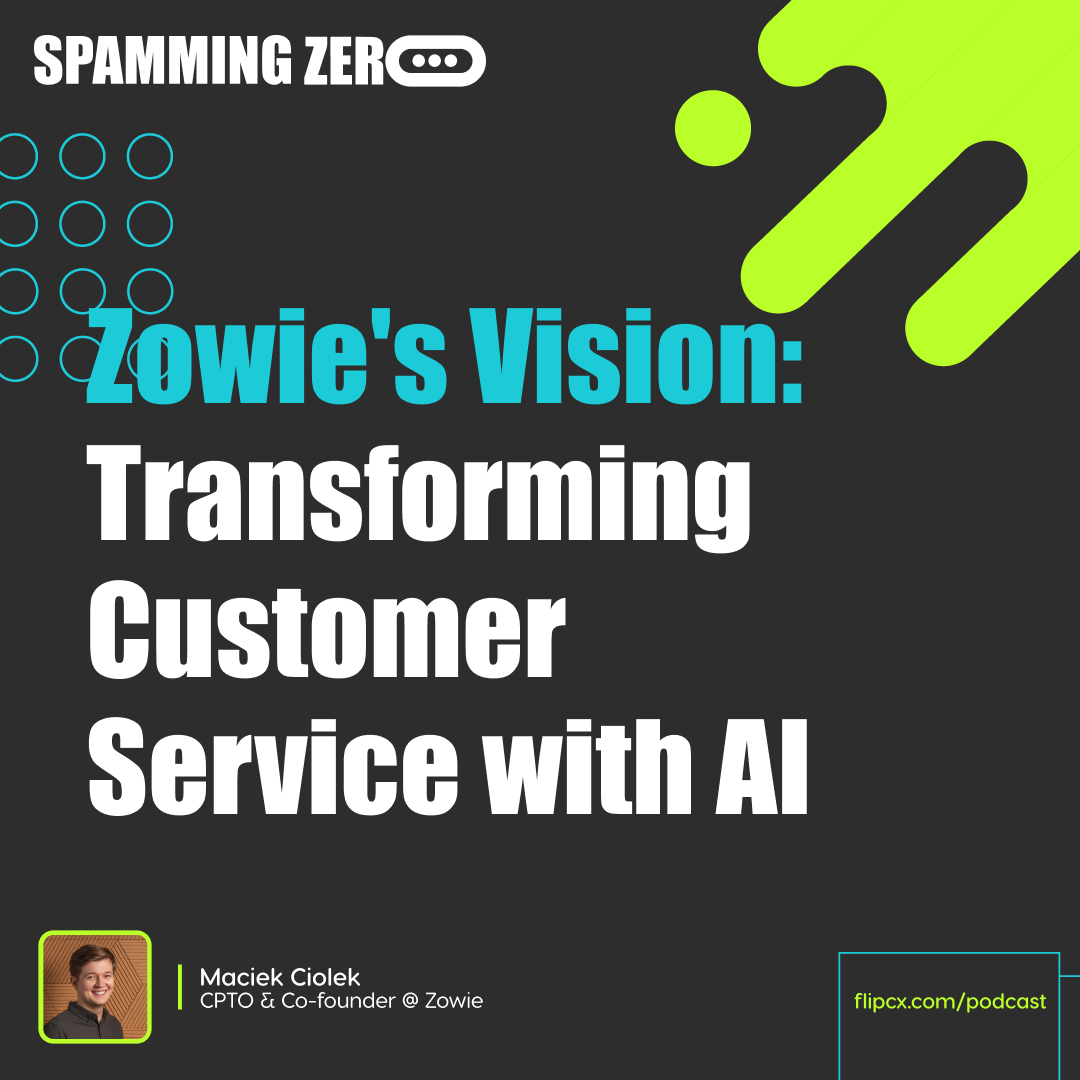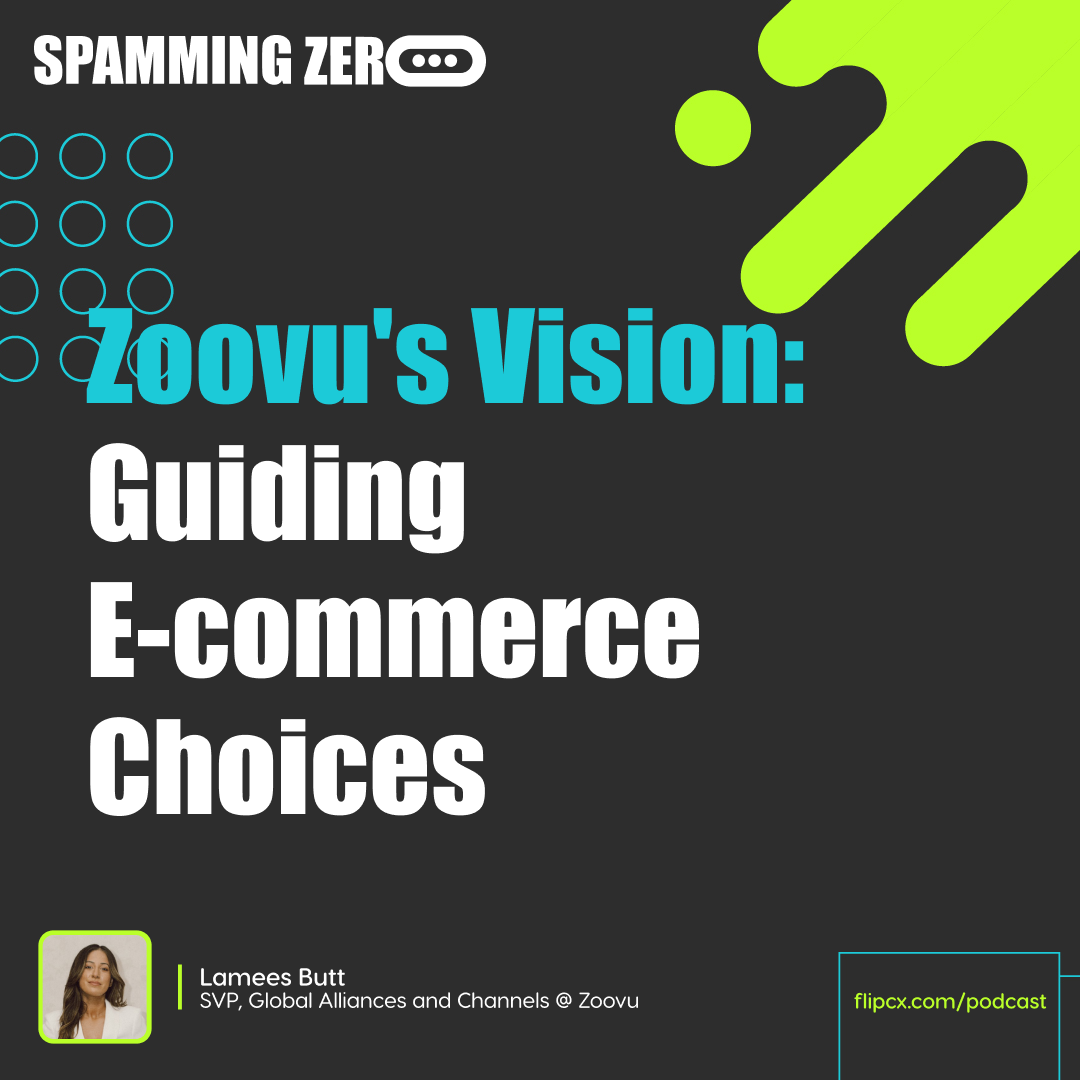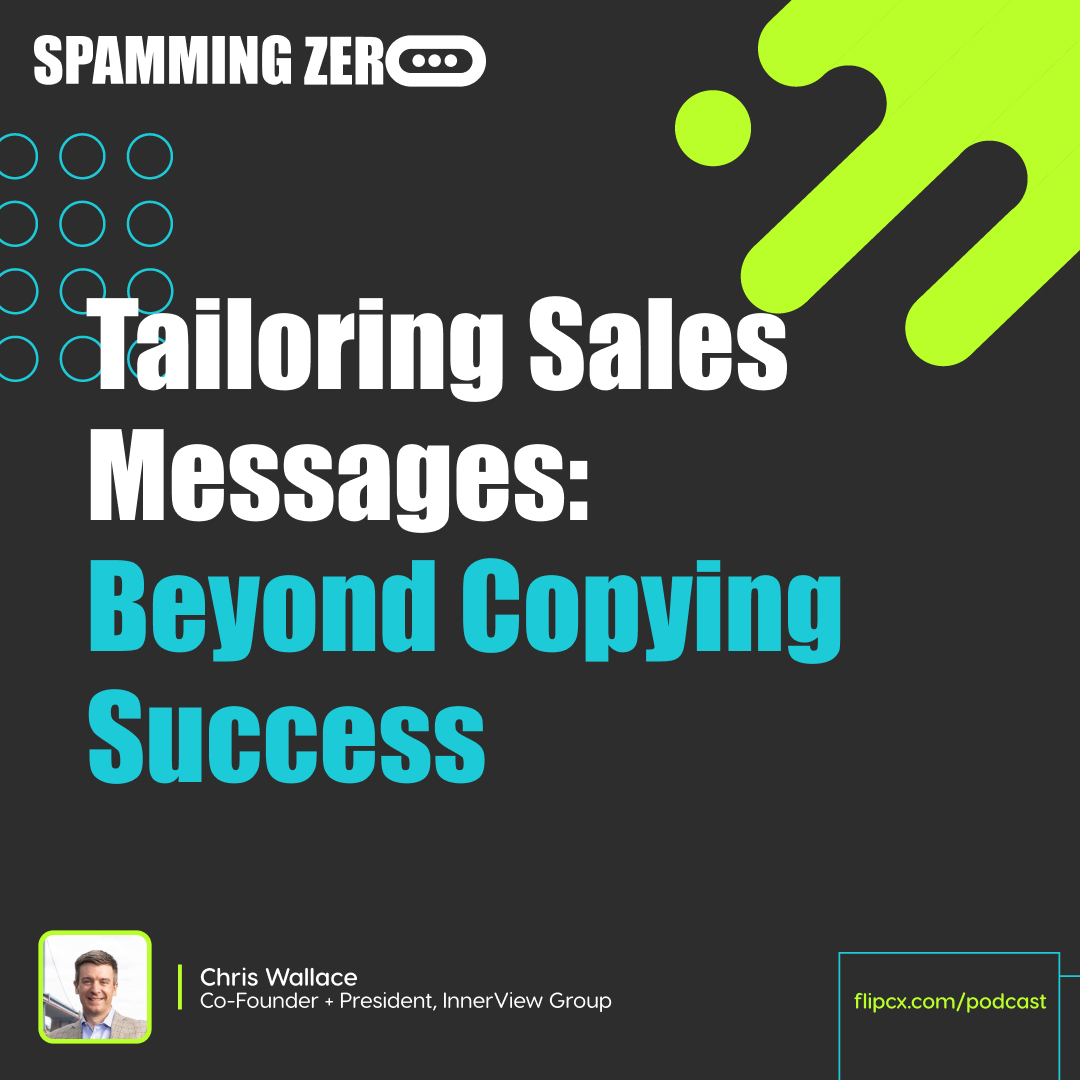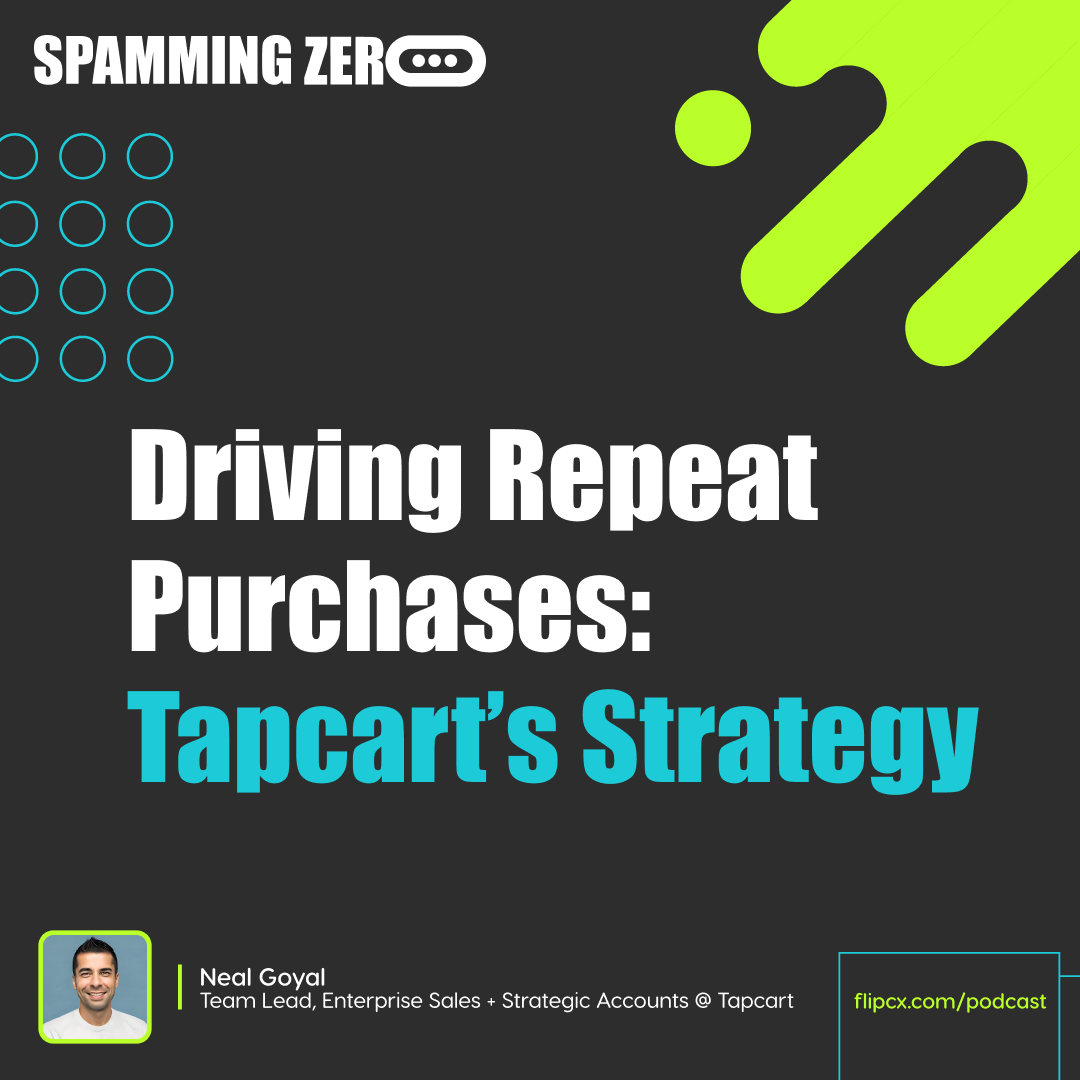Episode 38: Top Tips From The Ultimate Customer Support Ops Expert
- 0.5
- 1
- 1.25
- 1.5
- 1.75
- 2
James Gilbert: Hello and welcome to the show, Spamming Zero. I'm one of your hosts, James Gilbert. We're excited because this month's sponsor is brought to you by CXperts. If you need help with your digital experiences, especially when it comes to the customer experience overall and the strategies there, reach out to cxperts. io. They're an incredible team and incredible people that work there. They believe in three pillars of customer experience: CX Insights, better understand how your users interact with your brand online, CX Optimization, make improvements for your customers and your business goals, and then CX Launch, empower your team to make CX a part of your toolkit for success. They are the experts when it comes to customer experience and they would love to work with you. Again, cxperts. io. I'm James.
Brian: And I'm Brian.
James Gilbert: And this is Spamming Zero. Welcome, everybody, to another episode of Spamming Zero. We are joined by Hosam Hassan. Welcome to the show.
Hosam Hassan: Thank you, guys.
James Gilbert: We have been engaged with Hosam on LinkedIn for a while now. We didn't even know it, but we were just naturally engaging with each other's content, all three of us. We loved your stuff. You were loving our stuff. So we're like, " We really got to get him on the show." This is where we're at. Tell the listeners a little bit about your background.
Hosam Hassan: Yeah. Thanks, James, and thanks for having me on guys. So currently, I'm doing a couple of things. So my full- time job is at a company called Ultimate, and they do something a little bit similar to what Flipped does, but we're more on the email and chat side, so AI- powered auto responses to customers but in the text world. Prior to that, I was at Zendesk Consulting, running support ops, small consulting agency, and that was recently acquired by PartnerHero, which is also a big company in the CX space.
James Gilbert: I'm curious. You have some predictions for us that we talked about. What's your prediction for customer support teams moving forward?
Hosam Hassan: I've been in customer support for over a decade, and maybe the last year we've seen some crazy changes happening. The most rapid changes that I've seen, including AI, automation, the changes of the CRM world. So what I'm thinking in 2023 we're going to see a lot of is a combination of really good skilled humans, so we're not going to double down on having many layer one support staff. We're going to level them up to maybe tech support or level two. We're going to see those skilled workers coupled with AI, and a lot of people are calling this augmented agents now, and having really powerful operations tools on the backend, all the help desk software like Zendesk, third- party apps that are doing automation. That's all going to come together in I think 2023.
Brian: This is such a fun conversation for us to have because sometimes, you're just, whatever, engaging with people on social, but I feel like very often, the three of us are posting things that are really speaking to the same vision and point of view. There's almost two fighting forces going on here. One is the AI and customer service narrative has been around as long as customer service has been around, at least in the digital format that happens now. So that just brings skepticism. And then on the other side of the coin, there's everything that's happening with the economy right now and people are forced to look at these things in a way that they weren't forced maybe 12 months ago even. It's culminating in this, okay, we're all going to get a litmus test on where is this stuff really at right now because there's high motivation to adopt given the times and it's like, all right, there are a lot of new vendors right now, us and you guys included, and we are preaching a new wave of technology that can deliver against the dream that's been around forever. And now it's like, all right, the next 24 months, there's going to be plenty of people that purchase and what's the outcome going to be and how well is it going to play out?
Hosam Hassan: Yeah, no, I agree. I think prior to even the recession right now or the economy's state, a lot of people looked at our products as nice to haves. And in 2023, we're seeing that it's no longer a nice to have. People are understanding that this is a must have if you want to do more with less, which is a model we hear often these days and they're really getting it. And I think what's throwing the gas on the fire is ChatGPT. I don't want to make this episode about that, but it's unlocked inaudible. Yeah. That unlocked the imagination of a lot of these customer support managers, customer support teams, and they're like, oh, now I really get what Flipped does, what Ultimate does, what the other vendors do because it's something that they could play with really quickly, understand the concept and then be able to translate that in their day- to- day workflows.
James Gilbert: We've always heard this saying so many times in all of our lives of meet your customers where they are and in the channels that they prefer. And we've been hearing that forever, meet them in their preference channel and so many things. But I think there is also going to be, I guess you could call this my little 2023, 2024 prediction.
Brian: Dun dun duuun.
James Gilbert: Yeah. I think you're going to see more brands invest in more channels to meet their customers. Here why. One, they can't afford to not be in the channels that their customers are not in. And number two, if you're anything like me, which you all are because you buy products and you buy services and you need support for them, so if you're anything like me and you buy those things, then you need the support and the story that I have literally just happened before this podcast. I was checking our rental car because I'm going to Hawaii. It's going to be really fun. We got a rental car and I was checking my reservation but it wouldn't let me reset my password. So the first thing I did was try to do self- serve and get online, go through chat, look at their stuff and nothing is there, nothing with FAQs that's going to send me through any different of a loop than I've already gone. So I type in agent. I wait 45 minutes and I don't get a response through chat. So I see the phone number. I pick up the phone number and finally get an agent, but it was first through an IVR, and then I finally get an agent on the call and they fixed my problem right away. I think it's important for brands to realize the days of hiding these channels because you don't have the ability to service them are over. Customers are expecting it. And I think that the brands that decide to make the decision, " We're not going to have that channel or we're not going to serve people in that area. We're going to force them down a certain path," are going to see a massive reduction in their revenues from people that are consuming their products.
Hosam Hassan: That takes me back to doing Zendesk consulting. I would always tell my clients, this might be the opposite of what you're saying, but I would tell them, " Don't turn on channels that you're not ready to support." When you buy a tool or a suite that has all those options, phone, SMS, WhatsApp, Instagram, you're thinking like, " Okay, I have let's say two, three support people. I could turn on all those channels and we'll be able to help everybody on every channel." But that's not going to happen, especially with smaller support teams. So you should, my perspective and what I used to tell them is like, " Master one channel. Get everything in order. Get your operations documented. Get your process documented. Once you've mastered that one channel, then you could open up automation channels. You could open up social channels. You could start spreading that message across those different channels." But what they'll do, and this is probably your case, is they're like, " Okay, we want to deliver realtime support to James and his family. Let's turn on chat." They turned on chat but they had nobody to watch that channel and they ended up dying out there.
James Gilbert: This is why I think that when you couple it with what your prediction is, which is like AI is going to take this thing off, and with what Brian said, I think when you couple it with those other two predictions, that's what I'm saying is going to be really powerful because then, brands will have the ability to serve people in channels even when they don't have necessarily the full scale structure to be able to do it. A good example of this is, Brian, you know this, we've implemented a phone number for people that have reached out to somebody and be like, " Yeah, we can't really do phone support right now," but why not? Turn it on. And we grabbed a phone number for them and literally, the only option that they have is to go through our voice AI automation on the phone. And guess what it does? It gives those customers though the ability to go to that channel. And I think that more and more with the revolution of AI, I think we're going to see more brands being asked to do those kinds of things.
Brian: The other overarching layer here is there's been this is customer services, customer experience a profit center or a cost center thing that's played out going back in the contact center forever? And the economic times right now are really forcing companies to, in literal terms, put their money where their mouth is because it's one of the highest spend areas in any organization. It is not, in 99% of cases, directly attributable to new revenue. And for all of those reasons, it's a classic cut area. But then at the same time, on the other side of the coin, you have all of these brands that are in the public spotlight right now, especially when you talk about the D2C and consumer world but really everywhere right now. And they're talking about what the path forward is for their business, and the word that you see pop up again and again, read the investor things that the public companies do, everything, they always use the word brand and brand is going to differentiate us going forward. And then you just work backwards from brand and you say, okay, well if brand is the sum of every interaction, then interactions are the conversations that are happening and that directly goes to the customer experience. And it's like, do you really believe that brand is the path forward and that customer experience is the building block of brand or do you really believe that it's all about just getting credit card swipes and running away and keeping everything after the first purchase as cheap and as minimal as possible? People have been looking at this and asking this question forever and now they need to decide. Okay, you need a cut budget. Where are you cutting budget? Okay, you need to focus priorities. Where are you focusing priorities? I almost think that there's going to be a divergence that happens. If right now things are mostly consolidated around the middle and everybody is the same, I think that you're going to see the data points move to the extreme and you're going to see a lot of companies that really lean in and really thrive, and then you're going to see an equal amount of companies where it falls off the rails. If it's underwhelming right now, it's going to be laughably bad in 12 months.
Hosam Hassan: Yeah, I agree. I don't know if this would be a third path, but I like to think of customer support as a feature to your product and not necessarily a department. Traditionally, we look at them as-
James Gilbert: I like that.
Hosam Hassan: ...customer support agents. They're humans doing a specific task after you've sold your product or your customers are failing with your product. I look at customer support as a feature of your product. So at first, developing a feature is going to cost you money. Any feature that you dump engineering resources or any resources in general, it's going to cost you money. That's why we go get VC money. But after you've developed that feature, you could expect it in the long run to attribute to the profit of your company in the form of reducing churn, for example, for customer support, or if you're able to train them in some sales aspect where they could do upgrade. When I was a support agent, I would always try to do upgrades because I know customers are maybe on the wrong plan and they're not happy with the products. So getting them on the right plan is crucial and that will make you, most of the time, more money, unless it's a downgrade. So invest first and then eventually you'll stop your losses, reduce your losses or actually start making money from that feature, which I say is customer support.
James Gilbert: So one of my favorite predictions moving into this new year was a gentleman by, you guys should know this gentleman, his name is Jay Baer. You know Jay? Talks a lot about brand.
Hosam Hassan: He said I should, so now I can't say I don't.
James Gilbert: He talks a lot about brand experience. He's written a lot of books. You would know him. If you saw his face, you'd be like, " Oh yeah, I know him." He's the owner of Convince& Convert, and he really boils down the future of customer support into three bullet points. Number one, self- service. Number two, community- based service. Number three, predictive support. We've talked a little bit about self- service, having the ability to go out and do that yourself. We haven't talked about community- based service, and I want to hit on this for just a second because I think it's important and I think you could provide a lot of insight here. There's two brands that I think about that did this really early on and they're actually both in the same space, so they're not in D2C so I'll just talk about them as a software company. But Salesforce did this really, really well. They basically developed an entire community of developers to help figure out how clunky their system was. And then they said, okay, developers, go teach everybody how to do this. And what did they do? They built a massive following and that pigeoned their brand to do some of the stuff that they do for Dreamforce, their certification programs. It built all of that and it was all community driven. Another brand that I think about that did this quite well was early on, HubSpot did this really well. They built a lot of self- serve content, teaching marketers that even were not part of HubSpot's community, how to do marketing. So they built it first, value- led content. They removed their phone number for a very, very long time. HubSpot used to not have a phone number. And the reason why they did that is because they wanted the community to answer their questions. So in order for you to get a support question that needed... It was complex. They would have you submit it into the community. The community would vote on it. People would talk to you about it. Different HubSpot admins would come in and talk about it. And I oftentimes wonder why more brands are not building this community- based service where they're putting customers together and they're building that community so that they can help each other because ultimately, somebody has probably figured out the problem that you're having.
Hosam Hassan: Yeah, I think a couple of things here to answer your last question. I think companies don't encourage this or invest in it early on because they want to control the entire onboarding lifecycle for their end user. So if they say, " Here's the product. We'll let a random person onboard you or teach you how to use it," there's probably a higher chance of failure there if you have a complex product. So I think HubSpot and Salesforce definitely took a chance but they understood early on that educating power users and giving people certifications is going to be their key to growing because you can't continuously grow your customer success team. You're not going to handhold every single customer if you want to reach the scale that they're at.
James Gilbert: One hundred percent.
Hosam Hassan: So they thought of that early on and said, okay, we're going to take the risk, and I do think it's a risk, putting that support within the community's power. But when you take the risk and the outcomes are gray, then it's massive because look where Salesforce and HubSpot are at. So yeah, I think the startups of the world that don't take that risk really just want to control your onboarding experience and are afraid of failure.
James Gilbert: A direct- to- consumer brand might not be able to do their support necessarily through community led. They certainly could still do community led brand and building a community that helps amplify their brand where then they can discover new things about products. They can discover influencers through those communities. I think the possibilities are endless. Brian knows I am on this big community kick right now because I've helped build communities. They're really hard. They're tough to do. But I also just finished reading that book right there and it's amazing. I highly recommend it. I think it's some of the future of brand. I really do.
Brian: Shout out to our partner at Chatdesk. They are a solution provider that you can tap into, and their whole model is we are going to recruit the super fans of the brand to, at least in social channels, be an extension of it and handle support and community engagement there. So it is taking some of that. Hosam, I'm curious. How many people are you talking to now, CX and support leaders that have genuinely found and are focused on directly attributable revenue generating activities and plays that their teams are doing?
Hosam Hassan: I think right now because of the economy and well everything in the news, a lot of people, and we see it all over the place, there's layoffs happening all over the place. Nobody is really thinking about making more as much as just saving what they have. So I wouldn't say I'm talking to many people that are in that proactive state right now. I think a lot of people are just in reactive and adjusting. And also, I'm more in the SaaS world, so not really big transactional businesses like e- commerce, for example, and retail.
Brian: I bring it up because there are a couple of customers of ours that I would say forever have been very confident in what they're doing and felt that they were at the cutting edge and they were innovative. But especially now, those people and those leaders are walking around with their chest out and with a little bit more moxie in their step and a little bit more confidence in what they're doing and a little bit less of the retreat and recede and keep it as cheap as possible and hope that my budget is not the next one that gets cut. What is the theme that is putting people in one bucket versus the other? For me, what I've noticed is the people that can directly attribute revenue, and you're right, mostly we're doing entirely B2C businesses. So the ways of achieving that are different and probably in some ways more measurable, but it's definitely a clear split again that has happened. And then it's been cool talking about community for us to start to be the people that are connecting the dots for our customers and using our microphone in this case as a mechanism to get those people's stories out and into the hands of other people that are in similar companies that could run similar plays. Think about anything that any business is doing. There's a lot to learn from other companies at a similar stage doing a similar thing. So I think that's been cool.
Hosam Hassan: Are you seeing any trends as far as the type of products they sell or the amount of revenue that they're making a year? Are there any patterns that you're noticing it or they're just random companies that are just well- prepared and now they're, like you said, putting their chest out and saying like, " Yeah. We were prepared so we're good. We're good at this point?"
Brian: Great question. A lot of mid- market where later stage startup where they're at some level of maturity. That seems to be the stage. And then the other theme that they have is they have executive leadership that set the expectation at the get when they started the company, when they stood up the department, that CX was going to be a direct revenue driver. So that's the other layer.
James Gilbert: But here's the thing, Brian. You know this because we're seeing this all over the place. Whether you're in B2B or B2C, we're seeing this shift happen where CX and retention is a primary business focus even for investors and board members more than ever actually in the history of time. Right now, we're seeing that.
Brian: But that's still talking about CX as a form of retention, which to me, at a human level, that's very obvious. It makes perfect sense. Think about attribution software deal. It's very hard to measure A's impact on B. What I'm talking about is literally generating new sales, new purchases.
James Gilbert: That's what I'm talking about. Legitimately, I know CMOs right now that were asked by their board to cut all of their marketing budget, all their growth marketing budget and to focus 100% on customers and what they can do to amplify current customers and to net new sales. I'm not talking about upsell cross sells because that's more the customer success side of the house. I'm talking about leveraging their customers as the amplification of growth. I think it's happening more than it ever has in the history of time right now in business.
Brian: So you're saying lean into the existing community of super fans in order to have them spread the word, generate affinity and drive net new business through the door.
James Gilbert: I think there there's some of that for sure. There's definitely a community play there. I don't know. I just find it really fascinating. This evolution that we're in right now, it's wild.
Brian: It really has been a jump from extreme to extreme.
Hosam Hassan: When I was in the trenches doing support tickets, support people were not talking to product. They weren't talking to engineering. They weren't talking to marketing. And now, they're considered a real department and they're talking to these other departments sharing data, and I love seeing that. And for a lot of businesses, like you said, James, that moves the needle for them. You don't need to have all of your money going to one department, which is sales or marketing or product or engineering. If you spread it across the departments, you could see support departments, for example, shine and they could bring you a brand new take and they're the ones talking to your customer. A lot of times, your customer, their end user will never talk to anybody at their company until they talk to a customer support agent. That's the very first human contact. So you got to expect that those people have some good insight there.
Brian: Insane amount of insight.
James Gilbert: For real. It's this treasure trove of data that's just totally untapped. And we've talked about this several times on many other episodes. I want to shift gears here for a second.
Brian: Wait. I want to go one more layer there and then we can shift gears.
James Gilbert: You got it.
Brian: So I'm curious. So when you talk about the insights that come out of the support department, as automation technology starts to spread, one of the very obvious things that it can do, whereas AI spreads, one of the obvious things it can do is be a way of extracting, aggregating and distributing those insights. There are vendors out there. So I guess where this question is going is I'm curious how you think that the tech and the vendor landscape around these AI tools is going to evolve over as it enters this next stage of maturity. You see a lot right now of, within automation specifically, there's channel specific, there is industry specific, there is size and geo, those classic things going on. But then you also see this divide of this is AI that is actually going to automate the conversation. This is AI that is just going to do the analytics. In analytics, I would put tagging and that stuff, like automated tagging.
James Gilbert: AI.
Brian: Yeah. And then there's also the agent assist analytics and AI, and those are really three. If you go into the long tail, there are even more applications that people are using. There's the crazy company that raised money recently doing automated language and accent translation.
James Gilbert: Oh yeah, I saw that.
Brian: Which is wild just as an application of AI. But I'm curious. Do you see more of these things coming under one roof? Do you see more integration of these different tools and people leaning into best of breed? How do you see I guess the AI layer of the CX stack evolving?
Hosam Hassan: Yeah. Those are all great points. It's something that we've actually been chatting a lot about this week at Ultimate. So I've been trying to remove the term AI from my vocabulary just this week so I could look at what's happening underneath. So right now, it's a buzzword, even though there's super powerful technology behind it. So I'm just looking at each one of these pieces and like you said, there's a conversational piece which they're calling conversational AI, but there's so many other types of automations or what I've been calling bots this week. Bots doing different tasks for the support agent that they normally don't have to do. So the first thing we think about when we say AI, you think of a chatbot. It's going to have a conversation. But when a ticket comes into an agent, they have to, one, first analyze the ticket, route it to the right place, tag it, eventually send a response, then pull information from other systems to help them solve that request. Once they've solved that request, send a CSAT. Once the CSAT goes out, you have to pull analytics, you have to take those reports, push it to different teams. So the conversation itself is actually a very small piece of the entire ticket. So we have to look at them as individual pieces. And I think companies that are going to focus on one or a few of these will be really successful. And we see it all the time in industries. Companies that try to do everything and try to be all in one sometimes are really successful, but most of the times, they don't make it. So focusing on specific industries. We're doing right now customer support automation for Zendesk and Salesforce, very specific and mostly in the enterprise world, so very specific to what we handle. And we're doing conversational AI. That's our strength, but we're also doing integration to other tools specifically in your customer support tech stack. So we're not going into sales. We're not going into marketing. We're not trying to be everything for everyone. We're trying to be very specific, and I think we're going to see a lot of that. I think there's 10 new AI apps popping up every day, especially the last couple of weeks. So we're going to see very small apps doing very specific tasks.
Brian: I agree with that a hundred percent. I love how you jumped to winning in specific industries on specific tech stacks for specific use cases. That's same way that I see it playing out.
James Gilbert: Yeah. Here's the thing that I will say though. Coming from a function that wanted tons of tech to help it be more efficient and automate it, meaning marketing, and now seeing the landscape of how much tech is out there. And the problem that it's causing now 20 years after the fact, we see technology grow and grow and grow and grow. So I guess this is my warning for D2C brands that are investing in AI, which I think they should, there's no question about that. But my warning is this. Don't just invest in a niche solution like we're talking about if it doesn't have a long- term roadmap to integrate with all the other stuff that you're doing because then what you're going to be doing is what all these big brands did with tech and they brought on a niche solution for a very specific problem and then they were stuck with it and then the data became a bigger problem because then they couldn't access it. And so that's my warning a little bit with some of this stuff. I think that there are going to be a massive amount of companies that can leverage all these apps for the very reasons that you just mentioned. And I think that it'd be massively beneficial to do that. But I also think that they really have to think through not making the mistake that really businesses made with marketing. And now there's so much tech out there that you almost can't do your job without six tools doing it, and it's become such a problem that now marketers have to hire rev ops to run their business.
Brian: That's the beauty of software vendors going to market in an ecosystem led way. Right?
James Gilbert: Agreed.
Brian: Hosam instantly jumped to the example of Ultimate and Ultimate's go to market, and the first thing that you said is Zendesk brands and Salesforce brands. So to me, it's almost like people again go to the extremes. It's like we're going to do best of breed everything. We're going to have a thousand tools or we're going to try and get one tool that does everything. I think that the middle ground there is the tech stack. There are 510, 000 companies that are just like you in your industry, near your size band and this is what their CX stack looks like. All five of these tools are integrated with each other. The companies have relationships with each other, and that combination, it's going to play well together. You're going to have the interoperability that you need. You're not going to have the silos and you're going to get the benefits of all of those vendors not trying to do everything. So I like that picture of the future.
Hosam Hassan: I want to touch on what James was talking about, the overload of tech. We see that I think not only in marketing. It's everywhere. And that's one of the original reasons I started Zendesk Consulting and getting into that support operation space, is because every company I worked for, that would happen. We would try Zendesk for two months. It sucks. Try Intercom for two months. It sucks. Try Salesforce for two months. It sucks. All the tools were great. And I think all the tools are actually the same. They all essentially do the same thing. It's about how it's implemented and knowing what features you need and don't need. So having a great procurement person on your team and a great operations person that's going to tell you yes and no, and actually maybe hire the expert that's going to set it up or set it up themselves is going to make the difference for you in tools because you could go buy the most expensive thing and marketing has the most expensive tools and completely fail and think that the tool is terrible, but that's not the case if you're doing your due diligence when it comes to procuring and configuring. And then to Brian's take there, you have two tools out there. You have platforms which I would call the bigger CRMs and then you have the tools that plug into it. So I think you could have a couple of niche products, James, that plug into, but you can't have multiple platforms trying to do the same thing. I've worked with customer support teams that are using three CRMs just for help desk and it blows my mind. You have to simplify and keep-
Brian: I love that.
Hosam Hassan: Have one platform and then plug in the F's that you need that are going to enhance that platform.
Brian: That's a great distinction to draw because it's so different if you're using three different help desks with one plugin totaling four tools versus if you're using one help desk CRM, whatever, with 10 tools plugged into it. The one that has 11 tools total is actually running a cleaner operation than the person that's got four.
Hosam Hassan: Yeah. It's just like our cellphones, one device, one platform, one iOS or one Android device, and you have all the apps that do many tasks for you. You still need all of them. Nobody is going to come up with one app that does everything, but your platform is solid and it allows you to switch apps, plugin apps, remove apps as you please. And they shouldn't be that expensive, those add- ons.
James Gilbert: True story. Me and my wife a little while ago, we wanted to switch from a smartphone back to a flip phone just because we're sick of all the notes.
Hosam Hassan: I have those phases all the time.
James Gilbert: Here's what's crazy. We legit tried it. We went and turned in our phones and we got a flip phone and, man, you just do not realize how much stuff you do on your phone. Our finances were on there, how I logged into my bank. It's wild. And so we ended up taking the flip phones back and bringing back the smartphone just for that reason. And I think that we're headed to that. There's so much technology that these things are going to be just second nature to people. They're going to be like, " Oh my, gosh. If I didn't have it, what would happen?" I think brands that are investing early on in AI are going to be the biggest people talking about that. If we didn't have AI, this is what it would be like.
Hosam Hassan: Question for you, James. When you went back to your smartphone, did you cut out any apps or did you continue to use it?
James Gilbert: Yeah, totally did. We don't do a ton of social media. I have to for my job, but if I wasn't doing marketing, I wouldn't have any social media apps, like zip.
Hosam Hassan: And that's what happens. So you're at the extreme, and I did the same thing. I had an iPhone. I had a thousand apps, super unorganized and I felt all that noise and I was like, the phone is the problem, let me downsize. And I did the same thing. I got a little Nokia. It wasn't a flip. Was it called candy bar style phone, right? Used that for a little while and I was like, wait, there needs to be a healthy medium or a healthy middle. So I got an Android phone and only put the apps that I actually used, and that helped me pair down a bit. So you don't have to be on either extreme. I think companies need to find that middle and say, yes, we do need good tools. We can't go only using one tool, but we also don't need a thousand tools that are improperly configured. We need to find the middle great tools that work that fit our budget.
James Gilbert: I really love your analogy of the phone. It's actually really well done. That's really-
Hosam Hassan: Now, it's documented. So if you guys use it, you know where it came from.
James Gilbert: So we like the folks that come on our podcast to be also seen as human beings. You shop and buy and you do all those things just like all of us. So throw the consulting hat away for a little bit. Pretend like you didn't know Zendesk and you don't know any of the other vendors. Pretend like you don't know what AI is. What is something that drives you wild when it comes to your own customer service and support stories?
Hosam Hassan: There's a lot that drives me crazy.
James Gilbert: Let's do it.
Hosam Hassan: Right. I don't like runarounds. If you don't know, tell me you don't know in any aspect of life. I respect that more than you passing me around and giving me fluff answers. If you don't know, just go find the answer. Tell me you don't know the answer. I'll go look for it somewhere else. I hate having channels open that don't actually exist. So if I level them up to maybe tech support or level two, I'm calling an airline and this happened to me last year. The airline is based in another country. It's already difficult for me to call them in the first place, but I end up calling them. I wait on hold and there's actually no US department. It tells you like, oh, if you want support in English, press whatever number and then you just stay on hold. But there's actually no US department. Nobody that handles US phone calls so you just end up in this loop, then you go through email. So hopping around different channels or going to channels that don't exist. I'm pretty patient so I would say I don't mind staying on hold. That doesn't kill me. It's just eventually when I do speak to somebody, it should be an efficient phone call because I understand people might be short staffed or whatever the case may be. They might not have flip implemented yet. And I think working in service industry gives me a little bit of that patience to wait for others. But yeah, I think it's just the basic most common things, wrong answers and just going to the wrong place for the answer.
James Gilbert: What's your favorite brand to shop at?
Hosam Hassan: What brands do I ... I'm not like a huge shopper. What brands do I love shopping at? I love going to... I'm a person that goes to the same coffee shop every day, the same place to-
James Gilbert: That counts.
Hosam Hassan: ... eatfor lunch every day. I like places where I have good interactions and the stuff doesn't even have to be that great. And I say this all the time and you probably see it on LinkedIn. I think companies that have sub- bar products but excellent support are way better than companies that have great products and terrible support or terrible onboarding. I'll go to the mediocre coffee shop down the road a hundred times because they're like, " Oh hey, it's Hosam. We know exactly what you want." You go in. You get what you want. Sometimes you get a freebie and it just feels good. You're getting an entire experience, as opposed to going to a really expensive coffee shop that has amazing hype, which usually has a crazy line, and my experience is terrible because I got to wait 10 minutes for everybody to take their Instagram photos of the coffee and their croissant and all of that. So by the time I'm drinking my coffee, I'm not even really that happy.
James Gilbert: I love that. Companies that sell their product and their experience and it is genuinely both of them.
Hosam Hassan: And that's why I say support is a feature. It's baked into your product. They're buying the whole thing. I would say it's an average of the onboarding, the product itself and the support. That's what your complete product is.
Brian: What really grinds my gears is when you go to the place where you're expecting the loyalty treatment and you're in a lot of ways going for the experience and then you get treated like dirt. I'm not that inaudible. I not that long ago got, I feel confidently saying, absolutely unnecessarily kicked out of my favorite neighborhood bar for absolutely no reason by somebody that I've known for years now, and that stabbed a hole in my heart and I refused to go there for a while.
James Gilbert: You should send this podcast.
Brian: I've earned more than that.
Hosam Hassan: I don't know how much of that I believe as far as getting kicked out inaudible.
James Gilbert: He did nothing. He didn't deserve it.
Hosam Hassan: In most bars, you get kicked out for something, but if a bar that you're loyal to, for you to get kicked out, you got to do a lot.
James Gilbert: We don't need to go any deeper on this story.
Hosam Hassan: I thought you guys were going to ask me this in the beginning, but we didn't talk about it much. And now that we're talking about brand and loyalty and experiences, for anybody that's watching this, this is the first time that I'm meeting Brian and James on a call. It's been LinkedIn interactions. And the reason I gravitate towards you guys is I feel like a familiarity on LinkedIn. When I first saw you, Brian, I think this was before James even started, I was like, all right. This guy is wearing a gold chain in his videos talking about AI. I love the New York swag because I'm in Jersey so I was like, I could connect with this person. You're funny. You're talking about things in a way that resonates with me and how I grew up and the people I grew up around. So it gave me that familiarity. And I was like let me interact with this guy. The posts are cool. He's talking about the same stuff in a different way. And before you jumped on the call earlier, Brian, I was telling James, you guys are just cool and doing things differently and I really like that. It's not like the same cookie cutter marketing out there. It's not the same cookie cutter message or trying to be whatever company is trying to be. You guys are doing your own thing, which is really cool. And that's why whenever I could promote you or even recommend you, I know your product is great, but I know the experience that comes with it is super important for me, and I hope it's as important for the people that you guys deal with every day. So I wanted to put that in the intro, but I'm glad we're talking about brand here and loyalty because I think it makes the most sense to bring it up.
James Gilbert: Well, we appreciate the shout out. When Brian hired me in our interviewing process, I think one of the things he's told me that stood out is I have always preached how the only way to do marketing really, really well, number one, there's no marketing leader out there or marketing person out there that really knows what they're doing. Marketing is testing. It's throwing stuff at the wall and seeing what sticks and then repeating it. And so one of the things that Brian and I talked about in our interview was because it's testing, why not test in a creative way and an unconventional way? Otherwise, you're just testing the same type of stuff that's already being tested out there. So in my opinion, you're much quicker to find what's going to work and what's going to resonate with people when you stand out and when you do something that's different.
Brian: I think I mentioned this at a little bit at the start, but it was the same experience for us and it speaks to part of the good that's on LinkedIn. How else would we have connected? Both of us were active, saw some of the things you were doing. I think at some point along the way, did a poll or something about phones and you DM'ed me and you were like, " I promise this isn't a personal attack." And I was like, God, I love it. I was like, I love it.
Hosam Hassan: Yeah. And I don't know what it was before that, but I also DM'ed you, " Kudos to the team. I love everything you guys are doing." Yeah, it was me knocking phone support. We could do a whole episode on that, but you see, you guys have converted me and I've been in support forever, but it was just my personal experiences on both ends of being a customer support agent and hating phone support and being on the customer side and also hating phone support, but then learning about this AI revolution just in this last six months. I'm like, okay, if you apply that technology to that channel, it does make total sense.
James Gilbert: This is why we asked that last question, to get a little bit personal with you because there is not a single person that I know at this particular moment that enjoys picking up the phone and calling support. And we make a promise, we are going to change that for people forever.
Brian: He goes to the deep voice on exit, and now the outro music starts.
Hosam Hassan: Boom.
James Gilbert: We are though. We're really going to change it. We're going to blow people's minds, flip it. We are just getting started.
Hosam Hassan: Can't wait. I'll see you guys in 12 months and I want to redo this, do this podcast here.
Brian: Hell yeah.
Hosam Hassan: Hear the results.
James Gilbert: Hosam, you've been awesome. Thank you for joining us on the show today.
Hosam Hassan: Yeah, thank you both.
James Gilbert: Thank you for listening to our podcast. Each and every week, you can find us, same place, same time. We will always be here. Every week, we have a new guest come on in the D2C world. If you have somebody that wants to be on the podcast or a topic that you want us to talk about, reach out to Brian or I, we'd love to have you on, or we'd love to talk about something that is relevant to you. If you have not yet subscribed to the podcast, please do so and give us a like and rating and we'd love that. Thank you.
DESCRIPTION
Ya’ know how, every now and then, you just click with someone out there in LinkedIn land? That’s how we came to meet this week’s awesome guest, Hosam Hassan.
As a Customer Support Operations Expert and Product Marketing Manager at Ultimate, Hosam brought stellar insights to the conversation, and it felt like an old friend giving us the inside scoop.
Naturally, we’re bringing that straight to you. On Flip CX’s Spamming Zero Podcast.
What’s Covered?
- Looking ahead: Hosam’s predictions for customer support teams
- How the new wave of AI tech is making its mark in the CS space
- Revisiting “nice to have”s versus “must have”s in today’s economy
- Your customers’ true channels of choice
- Hosam’s take on CS as a feature to your product - not a department
- What it really means to be community led
- Products & Revenue: trends and patterns Hosam has seen
- CX & retention as a primary business focus
- Utilizing the insights that come out of CS
- Choosing your tools wisely
- And more
Ready for more fantastic Spamming Zero conversations ahead? Listen, rate, and subscribe on Casted, Apple Podcast, or Google podcasts.
Today's Host
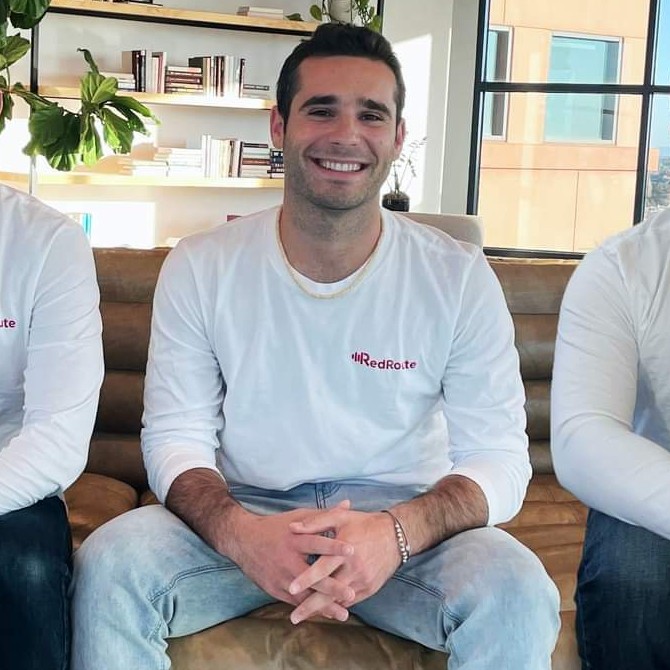
Brian Schiff
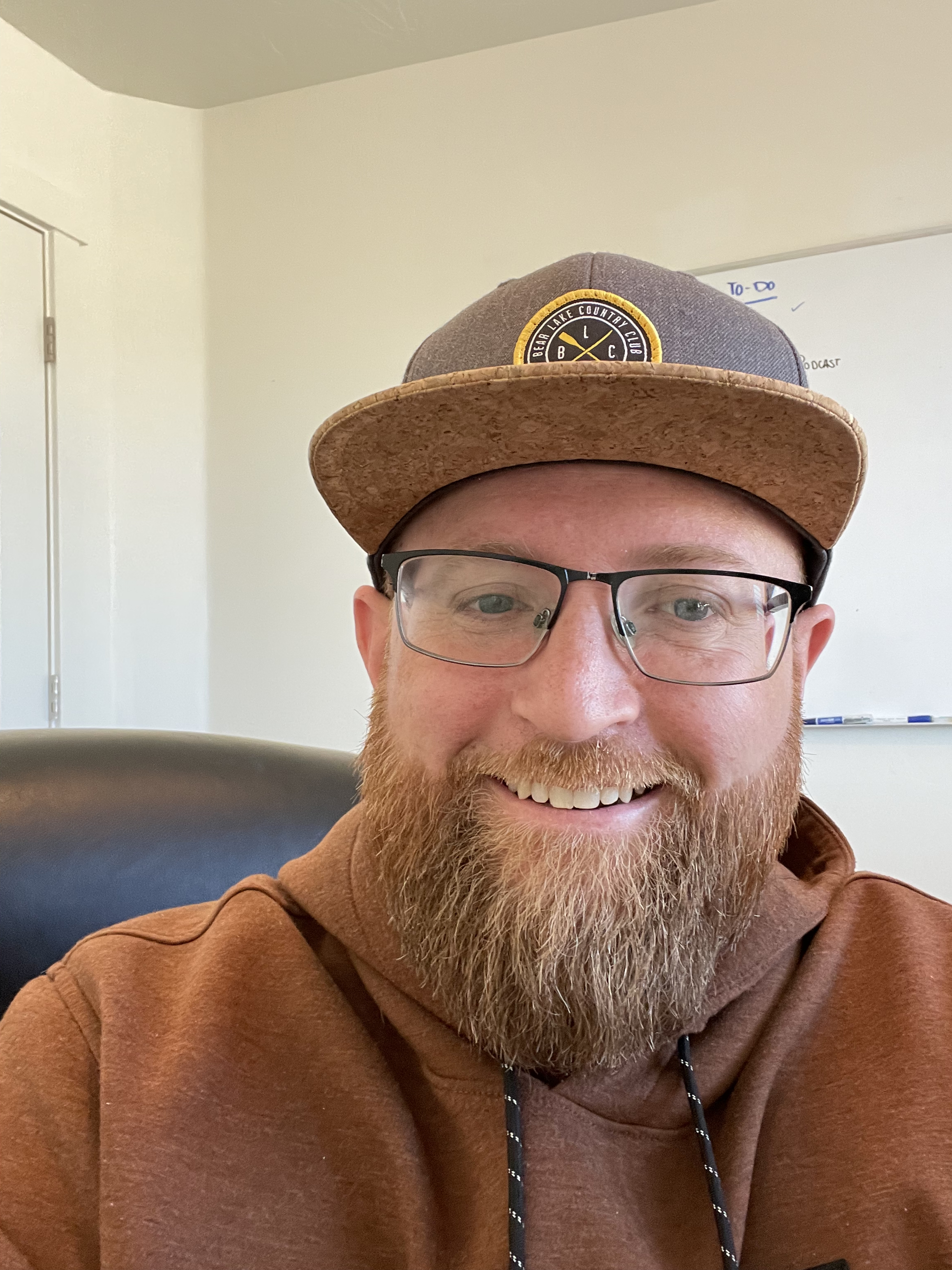
James Gilbert
Today's Guests
